2 中国科学院古脊椎动物与古人类研究所, 中国科学院脊椎动物演化与人类起源重点实验室, 北京 100044;
3 中国科学院大学考古与人类学系, 北京 100049;
4 陕西省考古研究院, 陕西 西安 710054)
20世纪70年代末,稳定同位素分析方法被首次用于探索美国北部地区史前玉米的最早栽培[1],开启了考古研究中古食谱稳定同位素分析的先河。至今,随着其理论方法的不断完善与创新,其在国际考古学研究中的应用不断得到扩展与深入。我国相关研究虽起步较晚(20世纪80年代前半叶)[2],但已在古人类(动物)演化[3~4],农业起源与发展[5~6]、人群迁徙[7~8]、文化交流与传播[9~10]、社会等级分化[11]、动物驯化与饲养策略[12]以及古环境变迁[13~14]等方面取得丰硕成果,成为我国考古学研究的主要方法之一。
随着我国古食谱稳定同位素分析工作的全面开展,越来越多考古遗址暴露出群体中存在个别个体具有迥异的稳定同位素值。目前,对于这一特殊现象的解释,主要集中在外来人群(或动物)的迁徙,例如陕西神圪垯墚遗址[15],山西大同北魏墓群[16]、新疆洋海墓地[7]、山东北阡遗址[17]、河南刘庄遗址[18]、河南瓦店遗址[19]、新疆多岗墓地[20]等。但随着具有地理指示作用的硫(S)、锶(Sr)、氧(O)等稳定同位素的进一步分析,具有特殊稳定同位素组成的个体或部分群体并非完全属于外来者,例如湖北青龙泉遗址个体M79、M133和M124[8],河北南城和白村遗址个体M70[21],河南贾湖遗址个体M341[22~23],陕西关中机场墓地个体JCM81[24]等。据此,我们不得不驻足思考,造成这些个体具有迥异的稳定同位素组成的真正原因是什么?而深入了解影响我国古食谱稳定同位素分析的各方面因素,可能为我们解密这一现象提供重要线索。
目前,国际考古学界有关古食谱稳定同位素分析影响因素的研究主要体现在两方面:一,利用考古遗址出土生物体组织稳定同位素组成的变化规律,判断其主导影响因素,进而探索与其相关的古代人类活动、社会经济发展以及人地关系等。例如,根据古代农作物稳定同位素组成的变化规律,推断其可能的影响因素(如施肥、灌溉、田间管理、轮作等),进而探讨古代农耕技术的发展[25];根据人体组织稳定同位素组成在性别方面不存在明显差异的特征,推断引起古代男性与女性食谱差异的非生理因素(如劳动分工、社会地位等),进而探讨古代人类社会组织结构的变化与发展[26~27];根据不同年龄段个体组织稳定同位素组成的特征与变化规律,推断引起不同年龄段个体食谱差异的因素(如母乳喂养、断奶与添加辅食等),进而探讨古代人类生长发育过程与营养健康状况[28~29];根据个体或群体某一时间段内稳定同位素组成的突变,推断可能引起其新陈代谢异常的因素(如食物短缺与疾病引起的饥饿与营养胁迫以及个体饮食习惯的变化等),进而探讨古代大规模自然灾害爆发与应对策略、疾病与医疗卫生等[30~34];根据不同时期、不同地域人(或动物)稳定同位素组成的变化规律,推断引起其食谱变化的自然环境因素,进而探讨古代人类食物资源的季节性变化、生存策略的演变、生存环境的变迁以及人群迁徙等[35~37]。二,古食谱重建过程中,作为对比样的现代样品与古代样品之间稳定同位素组成常存在一定差异。为避免这种差异对古食谱重建的影响,往往通过对造成这种差异的因素分析以及差异程度的判断,对古代或现代样品的稳定同位素值进行校正。例如,受炭化作用影响,考古遗址出土农作物种子的δ15N值相对于现代农作物种子富集约1 ‰ [25];工业革命以来大量以C3植物为主的化石燃料的燃烧,导致全球大气CO2浓度不断升高的同时,大气δ13C值则逐渐降低,最终引起现代生物体的δ13C值降低约1 ‰ ~2 ‰ [38~40]。另外,考古样品采集与储藏过程中,其稳定同位素组成也将发生较小变化[41]等。
国内考古学研究中,对古食谱稳定同位素分析原理的探讨较少。仅体现在:探讨不同气候因子对我国北方现代农作物(粟和黍)稳定同位素组成的影响,以及农作物不同组织稳定同位素组成的差异导致同一营养级人与动物(因取食农作物的不同组织)的稳定同位素组成存在明显差异[42~44];根据我国北方白水流域新石器时代晚期粟、黍稳定同位素组成的变化规律,推断古代人类农业施肥活动,以探讨我国古代农业技术的发展[45];探讨疾病引起的个体新陈代谢异常对个体组织稳定同位素分馏的影响[46];以及根据不同年龄段幼儿食谱的变化规律探讨古代人类生长发育过程与营养健康状况[47~48]。另外,因现代工业革命或区域气候差异引起的以植物为底层食物链中δ13C值的变化,被用于校正现代或古代样品的稳定同位素组成,从而更准确的重建古食谱[9, 49]。
根据古食谱的稳定同位素分析原理(“我即我食”),人类(或动物)通过饮食不断与外界自然环境进行着物质与能量的交换,并通过对食物的消化、吸收与代谢促进自身组织的形成与不断更新[50]。在此过程中,直接影响人或动物食物资源的稳定同位素组成或间接通过影响人或动物的新陈代谢,而最终导致人或动物组织的稳定同位素组成发生变化的一切外界或生物体自身因素,均可能对古食谱的分析产生一定影响。另外,动物喂养实验表明生物体对不同种类食物的消化吸收过程中稳定同位素的分馏存在明显差异[51];且不同烹饪方式引起的食物稳定同位素的分馏也存在差异[52]。我国作为两大农业类型(北方粟、黍旱作农业和南方稻作农业)的起源中心,先民的食物资源随着农业的发展与扩张不断发生变化[5~6, 8, 22, 53~59];且古代食物加工器具种类繁多(如鼎、釜、鬲、甑、灶、磨盘等)[60~63],已形成独具特色的饮食文化。因此,从外界自然环境、人类活动与生物体自身生理的角度,以我国古代独具特色的饮食文化为背景,综合探讨可能影响我国古食谱稳定同位素分析的因素,从而为更准确全面的重建我国古代人与动物的食谱提供依据;同时,通过对不同影响因素的诠释,揭秘其背后隐藏的考古学信息,为我国考古学研究提供更宽广的视角。
2 多因素对我国古食谱稳定同位素分析的影响 2.1 植物生理特征与自然环境因素的影响植物作为生产者位于食物链底层,其稳定同位素组成的变化,可谓“牵一发而动全身”,将导致整条食物链上不同营养级消费者的稳定同位素组成发生不同程度的变化。因此,影响植物组织稳定同位素组成的因素是古食谱分析影响主要因素之一。
一般而言,植物的稳定同位素组成首先取决于其遗传因素与自身生理特征。例如光合碳代谢途径的不同导致C3和C4植物的δ13C值存在明显差异[64];氮代谢过程和氮循环的差异引起不同功能型植物(乔木、灌木和草本植物)叶片δ15N值的显著差异[65];植物不同组织成分的不同造成不同组织稳定同位素组成的差异[66~67]等。其次,地理环境和气候因子(如土壤、降水量、大气CO2浓度、温度、光照、湿度、海拔、纬度等)的变化,促使不同植物的稳定同位素组成发生不同程度的变化,某些情况下呈现明显的地域差异[68~71]。这些因素通过影响植物的稳定同位素组成最终引起其消费者(人或动物)的稳定同位素组成发生相应的变化,从而为探索古代人类(或动物)的食谱演化与生存环境变迁提供理论依据。然而,我们又往往忽略了这些因素对古食谱分析的影响。
随着我国两大农业体系的建立与发展,新石器时代晚期南稻北粟的农业格局形成;新石器时代末期起源于西亚的小麦传入,又逐渐打破这种格局,并最终取代粟成为北方经济的主体[54, 56, 72~74]。粟和黍(C4植物)与水稻和小麦(C3植物),因遗传因素与生理特征的不同,两者组织的δ13C值存在显著差异(图 1)。正因如此,在我国古代独具特色的饮食文化背景下,稳定同位素分析的优势使其成为科技考古研究的重要手段[58]。但随着稳定同位素分析数据的不断增加,半定量的呈现古代人(或家畜)的食谱或先民的生业经济类型,已经无法满足考古学家探索古代人类社会更深层次内涵的需求。而大的时空背景下,利用稳定同位素对比分析探索古代人类生业模式的演变规律、不同文化的交流与融合、人与自然环境的互动等等,已逐渐成为稳定同位素食谱分析的焦点[9, 75~77]。
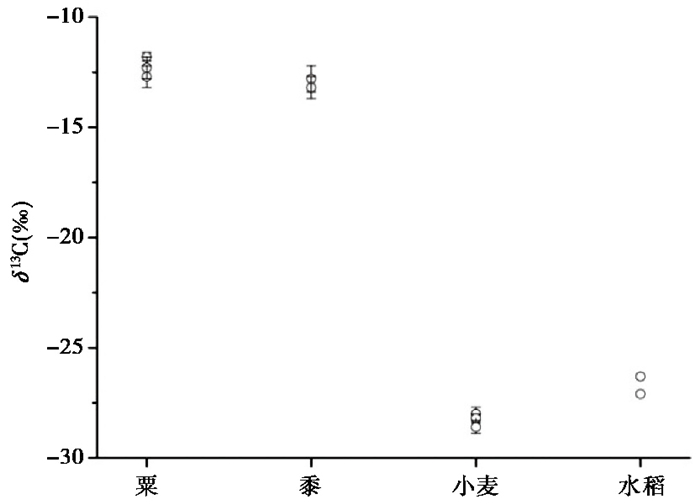
|
图 1 我国现代粟、黍、小麦和水稻种子的δ13C值[42~44, 78~81] Fig. 1 δ13C values of grains from modern foxtail millet, common millet, wheat, and rice in China |
与此同时,以往常被忽略的农作物稳定同位素组成在不同种属、不同组织成分以及不同地域之间的较小差异则需要重新考量。首先,农作物稳定同位素组成存在不同程度的种间差异。例如,现代或古代粟与黍种子δ13C值差异约为+0.6 ‰ [42, 44];现代不同品种粟(或小麦)种子δ13C值差异最高达1.0 ‰ (或0.3 ‰),不同品种小麦种子δ15N值差异约为0.4 ‰ [42, 81]。我国北方史前旱作农业发展经历了由黍逐渐转为粟的过程[82~83]。虽然,目前尚缺乏对古代小米品种的系统研究,但粟、黍之间以及粟不同品种之间稳定同位素组成的差异,可能对我国北方史前人类食谱演变的研究产生影响。其次,同一植物不同组织稳定同位素组成也存在差异。例如,粟种子与叶片的δ13C和δ15N值差异分别约为+0.3 ‰和+2.1 ‰ [42~43];小麦种子与叶片的δ13C值差异约为+1.2 ‰ ~4.6 ‰ [84~85],小麦面粉与麸皮的δ13C和δ15N值差异分别约为+1.1 ‰和+0.6 ‰ [81];水稻颖果与颖壳的δ13C和δ15N值差异分别约为+0.8 ‰和+4.6 ‰ [80]。我国古代农作物不仅是人类主要的食物来源之一(如粟籽粒和小麦面粉),其副产品(如粟秸秆与小麦麸皮)也常被用于家畜饲养[12, 86]。因此,农作物不同组织稳定同位素组成的差异将对古代人与家畜食谱的对比分析产生一定的影响。例如,新石器时代粟作农业区三处遗址中(西坡[78, 87]、东营[12]和神圪垯墚[15]遗址),人与家猪食谱均以粟为主(表 1)。人骨δ15N值比猪骨富集约1.1 ‰ ~2.1 ‰,其差异介于粟种子与叶片δ15N值差异的范围之内。如不考虑因取食农作物组织的不同对人与家畜稳定同位素组成的影响,可能导致过高的估算人类对动物蛋白的摄取量,从而影响史前家畜饲养的发展等相关考古学问题的讨论。
| 表 1 新石器时代粟作农业区人与猪骨胶原的平均δ13C和δ15N值 Table 1 Average δ13C and δ15N values of Neolithic human and pig bones from the millet farming area in China |
此外,已有研究表明,我国农作物稳定同位素组成与地理环境和气候因子也存在明显关系,如旱作农业粟和黍与降水量之间的关系,最终导致不同地域粟(或黍)的δ13C值差异最高达2.6 ‰ (或2.3 ‰),粟δ15N值差异最高达6.5 ‰ [42~44]。可见,自然环境变化可通过改变植物的稳定同位素组成,间接影响其消费者(人或动物)的稳定同位素组成。另外,自然环境也可通过影响人与动物的新陈代谢,直接导致人与动物组织的稳定同位素组成发生变化[88~89]。如图 2所示,距今4000年左右,我国不同气候环境中,家养或野生植食动物的δ15N值存在明显差异。也正因如此,植物(或植食动物)稳定同位素组成的地域差异,也可为古气候的重建提供依据;另外,因炭化或与埋藏环境中相关元素的交换,我国考古遗址出土植物或骨骼遗存的稳定同位素组成也将发生一定变化[80, 90~91]。
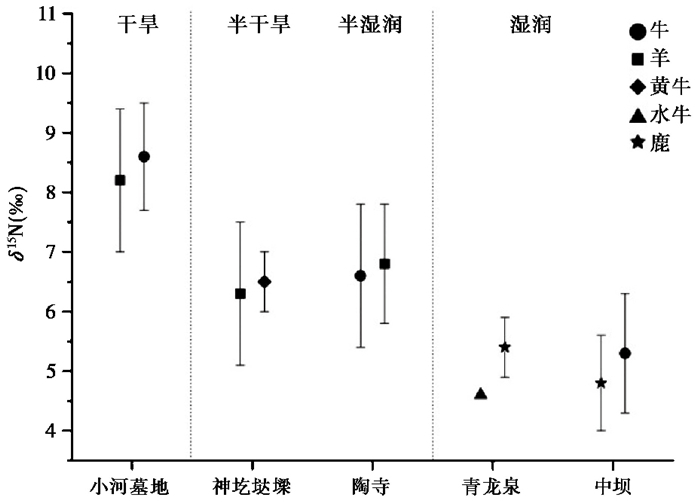
|
图 2 我国不同气候考古遗址中植食动物骨骼的δ15N值[10, 15, 49, 92~93] Fig. 2 δ15N values of herbivore bones from the archaeological sites in different climatic areas of China |
综上所述,不同的植物生理特征与自然环境因素对不同种类植物的稳定同位素组成将产生不同程度的影响;另外,由于人或动物食谱的复杂性与食物选择的随机性以及居住地生态环境的多样性,使得这些因素的影响结果不断发生变化。例如,农作物种子与叶片稳定同位素组成的差异对于人与动物食谱的对比分析将产生较大影响,但对于人与人之间食谱的对比分析则影响较小;同一生态环境中,自然环境因素对于不同个体之间稳定同位素组成的影响较小,但不同生态环境下,自然环境因素对于群体之间稳定同位素组成的影响则较大,等等。因此,在古食谱分析过程中,需要根据具体的研究对象与研究目的对这些影响因素进行综合评估,以确定特定情况下的主导影响因素。
2.2 人类活动因素的影响农业出现以后,刀耕火种的生产方式加快了古代人类改造自然的步伐,从而导致植被类型、气候、土壤成分等发生变化[94~97]。由此引起的农作物生长环境的变化可能对农作物的稳定同位素组成产生影响。与此同时,野生植物驯化过程中,人类对其生长条件的控制以及选种等行为,也可能进一步影响作物的稳定同位素组成。例如,我国北方现代粟(Setaria italica)与其野生祖本狗尾草(Setaria viridis)的δ13C和δ15N值存在一定差异[42~44, 65, 78, 98](图 3)。由于引起该差异的因素较多,尚无法确定农作物野生祖本驯化过程中因人为因素干预所导致的稳定同位素组成的变化程度。
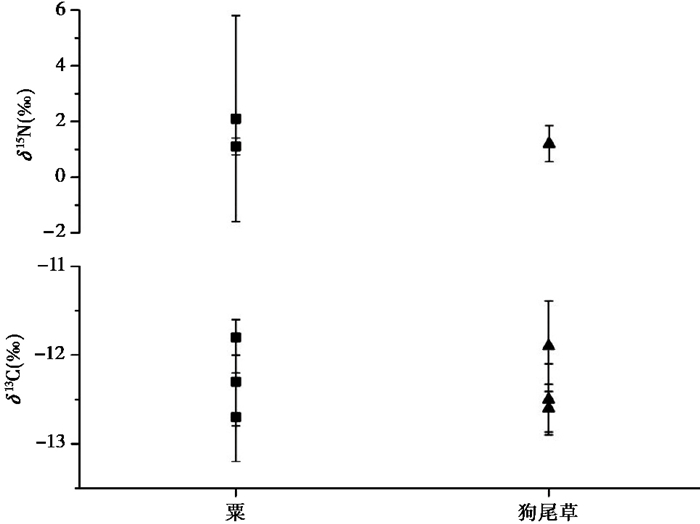
|
图 3 我国北方现代粟与狗尾草的δ13C和δ15N值误差图[42~44, 65, 78, 98] Fig. 3 Error bar of mean δ13C and δ15N values in modern foxtail millet(Setaria italica)and green bristlegrass(Setaria viridis) grains from Northern China |
家畜饲养作为我国古代人类农业活动的重要组成部分,为人类提供了稳定的肉食来源[99]。现代动物喂养实验表明,低质量食物或长时间食物匮乏引起的营养胁迫通过影响哺乳动物的生理代谢最终导致其组织的稳定同位素组成发生变化[100~102]。在家畜驯化初期,古代人类对其觅食行为的限制(如拘禁、圈养)与可能存在的食物供应不足(因古代人类对驯化动物摄食规律与摄食量的不完全了解所致),甚至对其繁殖、性情等生理方面的强加干预等[103],均可能导致其新陈代谢发生变化,进而影响其组织的稳定同位素组成。
以家猪为例,作为我国最早驯化的动物之一,其遗存在距今8000多年前的诸多考古遗址中被发现[99]。我国北方地区野猪食谱以C3植物为主,随着粟作农业的发展以及人类喂养行为的干预,其食性发生改变,致使其组织的δ13C值发生明显变化[6, 12, 17, 78, 87, 104~107],成为判断家畜驯化与饲养策略的重要依据[108]。然而,在家猪驯化的早期阶段(图 4),存在食性差异较大的不同个体共生的现象。如白家遗址猪和月庄遗址猪个体A的δ13C和δ15N值介于野生鹿与野猪(根据形态特征与食性判断为野猪)[17, 104]的范围之内;个体B的δ13C值显著升高,其食性变化与先民从事的粟作农业有关[108];个体C和D的δ13C值介于野生动物的范围内,但其δ15N值却明显增加。另外,在距今6000多年前吉林白城双塔遗址中,具有野生形态特征的猪,其δ13C值也介于野生动物范围内,但δ15N值却明显偏高[109]。由于古代人类捕获的野猪的年龄结构一般包括不同年龄段[99],个体C和D与双塔遗址猪的δ15N值明显高于所有野猪(包括幼年个体),因此,这些个体较高的δ15N值并非主要缘于母乳效应的影响。由此可见,在家畜驯化初期,部分猪个体在其食性尚未受到农作物明显影响且仍保留有野生体态的情况下,其δ15N值的明显增加,应过多的归因于驯化初期人类对猪习性与食性的强加干预所引起的新陈代谢异常。此外,人类活动对动、植物稳定同位素组成的影响结果,也可为农作物与家畜驯化的研究提供重要依据。
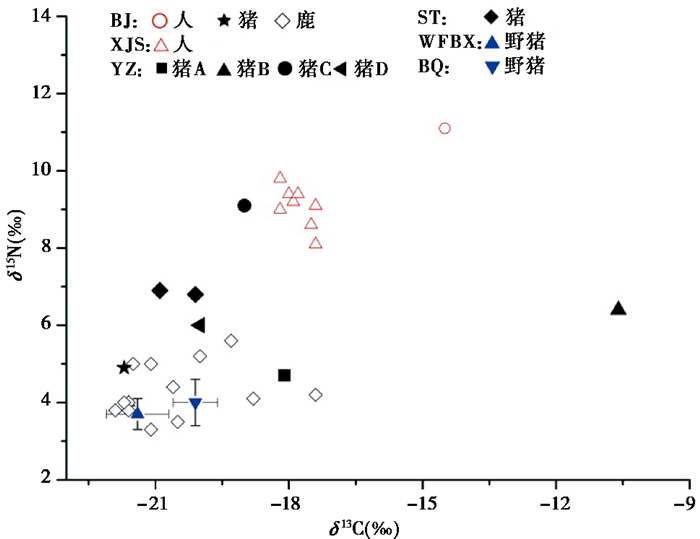
|
图 4 家猪驯化初期不同猪个体与人骨的δ13C和δ15N值 数据来源于白家遗址(BJ)、月庄遗址(YZ)、双塔遗址(ST)、小荆山遗址(XJS)、万发拨子遗址(WFBZ)和北阡遗址(BQ)[17, 104, 106, 108~109] Fig. 4 δ13C and δ15N values of pig and human bones from Baijia(BJ), Yuezhuang(YZ), Shuangta(ST), Xiaojingshan(XJS), Wanfabozi(WFBZ), and Beiqian(BQ)sites during the early pig domestication in Northern China |
古代农业技术的发展,如施肥、灌溉、田间管理、耕作方式等,促使人类通过改变土壤成分以达到农作物增产的目的,而植物的稳定同位素组成又与土壤成分密切相关[110]。因此,古代农业技术的发展将引起农作物稳定同位素组成的变化。例如,灌溉通过影响农作物水分利用效率,土壤硝化、矿化、氨挥发、反硝化、淋溶流失等过程,以及土壤成分的稳定同位素组成而改变生长农作物的多种稳定同位素组成[111~114];夏商周时期,我国先民开创了灌溉农业,至汉代,农业灌溉形成规模[115];中国北方地区古代农田以河水灌溉为主[116]。一般而言,河水因水分蒸腾作用导致其δ18O和δD值偏高,且呈现地域差异[117];另外,动物组织的δ18O值与氧的三大来源相关(饮用水、食物和空气)[118]。据此推测,河水灌溉将导致农作物(或家畜)的δ18O值偏高。同样,农作物(或家畜)氧同位素的分析也可为追踪农业用水来源提供依据。
我国河南省中部,商代中期小双桥遗址出土动物骨胶原的δ18O值明显高于二里头遗址(二里头文化)同种动物骨胶原的δ18O值[119~120](图 5),两者差异范围为3.2 ‰ ~4.8 ‰。两处遗址的气候均处于中原地区暖湿期[121],且两处遗址及周边地区,现代大气降水δ18O值的区域差异范围为0.2 ‰ ~2.5 ‰,现代黄河水系δ18O值的区域差异范围为0.1 ‰ ~0.4 ‰ [117]。可见,两处遗址同种动物骨胶原δ18O值的较大差异并非仅来源于两遗址气候环境的不同。另外,该地区不同水系的δ18O值依次为:黄河水系>大气降水>地下深层水[117, 122]。古文献记载与大量商代水井、输水和蓄水遗迹的发现,表明商代已开始引井水和河水用于浇灌和生活用水[123]。因此,小双桥遗址家畜较高的δ18O值可能与先民较多的引河水灌溉农业和饲养家畜等有关。
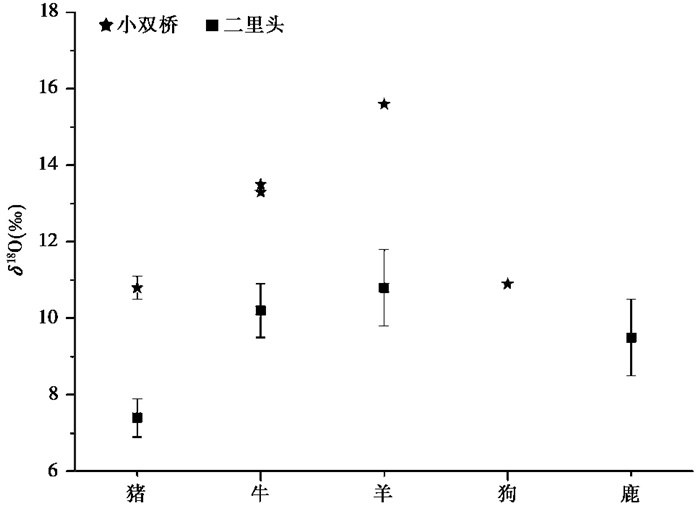
|
图 5 小双桥遗址与二里头遗址不同种属动物骨胶原的δ18O值[119~120] Fig. 5 δ18O values of bones from different animal species in Xiaoshuangqiao and Erlitou sites |
施肥可改变农田土壤中的氮库,从而影响农作物的氮稳定同位素组成[111, 114]。一般而言,农田土壤中氮浓度在一定范围内(即植物氮需求超过氮供给时),有机氮肥输入越多,植物δ15N值越高,且不同种类有机肥(绿肥、不同种属动物的粪肥)δ15N值存在较大差异;但当过多氮素的输入导致植物受盐分胁迫影响时,植物δ13C值将增加[111, 114, 124]。因此,古农田土壤与农作物δ13C和δ15N值的变化规律,可为探索先民不同的施肥措施提供依据。新石器时代晚期至商周时期,我国先民既已开始将粪肥(如猪粪)、绿肥施于农田[45, 125]。由于分别以C3植物或C4植物喂养的猪,其粪便的δ15N值将发生不同程度的富集(分别为3.3 ‰或0.9 ‰)[51],因此,新石器时代我国北方因家猪食谱变化而引起猪粪肥δ15N值的变化规律仍有待进一步研究。另外,由于浸水环境对土壤硝化作用的抑制,以及大量具有较低δ15N值的水稻根和秸秆的残留(土壤有机氮源),致使水稻田土壤δ15N值偏低[126]。由于植物δ15N值与土壤δ15N值存在明显正相关关系[69],据此推测,同一地区,水稻δ15N值可能低于旱作农业粟和黍的δ15N值。因此,稻粟混作区随着农业结构的转变,水稻与粟δ15N值的差异,也可能影响不同消费者的δ15N值。此外,我国北方地区自然环境中以C3植物为主[127],而粟、黍农业的起源与发展,导致过多的C4植物残骸融入土壤中,从而引起土壤δ13C值的增加,这为我国北方粟、黍农业的起源与古农田的研究提供新的视角。
此外,工业革命以来,人类对大量以C3植物为主的化石燃料的燃烧,导致全球大气CO2浓度与氮沉降不断增加以及大气δ13C值逐渐降低,从而对植物的C、N稳定同位素组成产生影响[39, 128~129]。一般而言,植物δ13C值降低约1 ‰ ~2 ‰ [39],动物与人骨δ13C值降低约1.5 ‰ [38, 40];而植物δ15N值的变化则较为复杂[129~131]。在中国北方地区,与古代粟和黍相比,现代粟和黍平均δ13C值降低约1.3 ‰ ~3.5 ‰ [45],该范围超出因化石燃料燃烧导致的植物δ13C值降低的范围;且古代与现代粟和黍的平均δ15N值差异范围也较大(1.2 ‰ ~8.1 ‰)[43, 45]。可见,现代与古代粟和黍δ13C和δ15N值的差异不仅与化石燃料的燃烧有关,也与人类的农业活动有关,是人类活动多因素共同作用的结果。
2.3 人体自身生理与健康因素的影响人体通过对食物的消化、吸收与转换形成自身不同组织,因此,人体组织的稳定同位素组成不仅与食物相关,还可能受个体因性别、年龄、健康状况、饮食习惯等不同引起的新陈代谢差异的影响[50, 132]。
动物喂养实验显示,摄取相同食物的雄性与雌性个体之间骨胶原(或磷灰石)的C、N稳定同位素组成不存在明显差异[133~134]。可见,性别引起的生理差异对个体组织的稳定同位素组成影响较小。我国多处遗址男性与女性骨胶原δ13C和δ15N值的对比分析显示(表 2),在不受外界其他因素影响的情况下,男性与女性的δ13C和δ15N值不存在明显差异。其中,姜寨遗址男性与女性δ15N值的显著差异主要与食物资源的分配不均有关[135]。因此,男性与女性食谱的差异往往作为判断劳动分工、地位等级以及社会组织变化等的重要依据[11, 27, 135~136]。另外,现代男性血液的δ56Fe值比女性低约0.3 ‰ [137];同样,考古遗址出土男性与女性骨骼的δ56Fe值也存在差异(0.33 ‰),因此,Fe同位素分析可为考古遗址出土人骨性别(尤其是幼年个体)的判断提供依据[138]。
| 表 2 我国考古遗址中男性与女性骨胶原δ13C和δ15N值的对比分析 Table 2 Average δ13C and δ15N values of female and male human bones and P values(T-test)from archaeological sites in China |
因新陈代谢速率的不同,不同年龄段个体之间骨骼成分存在一定差异[143]。目前,我国考古遗址中不同年龄段人骨稳定同位素分析主要集中在探索不同年龄段个体的食谱差异、劳动分工、社会等级等[20~21, 139, 142, 144~145]。为了解因新陈代谢速率不同而引起不同年龄段个体间稳定同位素组成的差异,我们根据不同年龄人体代谢和骨骼成分以及史前黄河流域人口年龄结构特征[146],将各考古遗址中人骨按年龄分为三组(第一组:< 10岁,第二组:10~40岁,第三组:>40岁),对比分析同一遗址中不同年龄段人骨稳定同位素组成的特征(图 6)。总体而言,受母乳喂养的影响,第一组个体δ15N值相对较高;第二组与第三组个体δ13C和δ15N值无明显差异,但第三组中存在个别个体的δ15N值较高,表明不同个体在年老时,因新陈代谢变化的程度不同,其骨骼的稳定同位素组成受其影响的程度也不同。
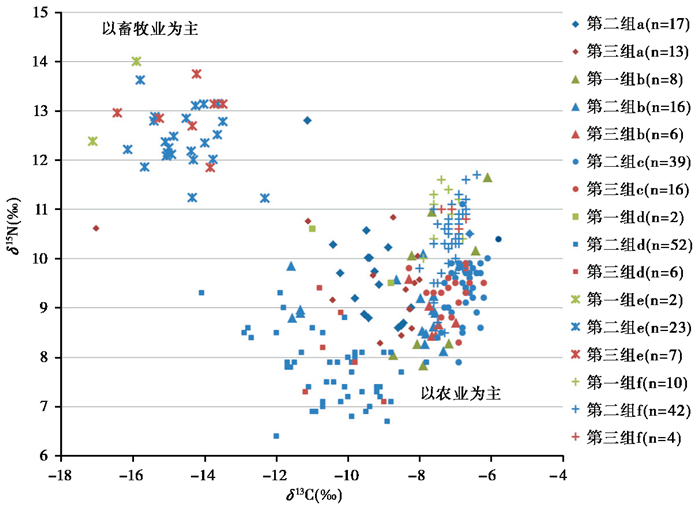
|
图 6 各考古遗址中不同年龄段个体的δ13C和δ15N值散点图 a——大同南郊北魏墓群[16],b——郑州西山遗址[87],c——河北南城遗址[21],d——河南晓坞遗址[139],e——新疆多岗墓地[20],f——山西聂店遗址[142];年龄划分时,如个体年龄鉴定结果为一个范围,则取中间值;年龄鉴定为“成年”,统计时予以排除;年龄鉴定为“未成年”,归入第二组 Fig. 6 Scatter plot of δ13C and δ15N values of human bones in different age groups from archaeological sites in China. a:Northern Wei cemetery in Datong City, b:Xishan in Zhengzhou City, c:Nancheng in Hebei Province, d:Xiaowu in Henan Province, e:Duogang in Xinjiang, f:Niedian in Shanxi Province. The age of individual in a range is taken by an intermediate value; the individual with the age identified as "adult" is excluded; the individual with the age identified as "minor" is classified as group Ⅱ |
疾病、生存压力、频繁活动、妊娠等特殊生理期可在短期内引起人体新陈代谢异常,从而影响个体组织的稳定同位素组成(如C、N、Fe等)[30~31, 34, 137~138, 147]。其中,最为常见的现象是机体承受营养胁迫时,为获取新陈代谢所需物质与能量,对其组织蛋白质进行分解与再合成时,导致14N流失,继而引起组织δ15N值增加;而脂肪分解产生的大量12C被机体重新利用合成不同组织成分时,将导致组织δ13C值降低[40, 147~148]。目前,因新陈代谢异常引起的人体组织稳定同位素组成的变化,为探索古代人群的生理健康、疾病卫生、营养水平等提供了新的视角[30~32]。
纵观我国多处遗址中同一年龄段(15~40岁)不同性别个体的δ13C和δ15N值[16, 20, 87, 139],发现个别女性个体具有特殊的δ13C和δ15N值(图 7)。与同遗址其他个体相比,其稳定同位素组成特征与遭受营养胁迫导致的个体稳定同位素组成变化规律相似(即δ13C值较低,而δ15N值较高)。随葬品显示这些女性个体无特殊的社会等级地位(如大同南郊北魏墓群)[16],且其年龄(20~35岁)也均处于生育年龄之内。据此推测,这些女性个体特殊的δ13C和δ15N值可能与其妊娠期经历的营养胁迫有关。
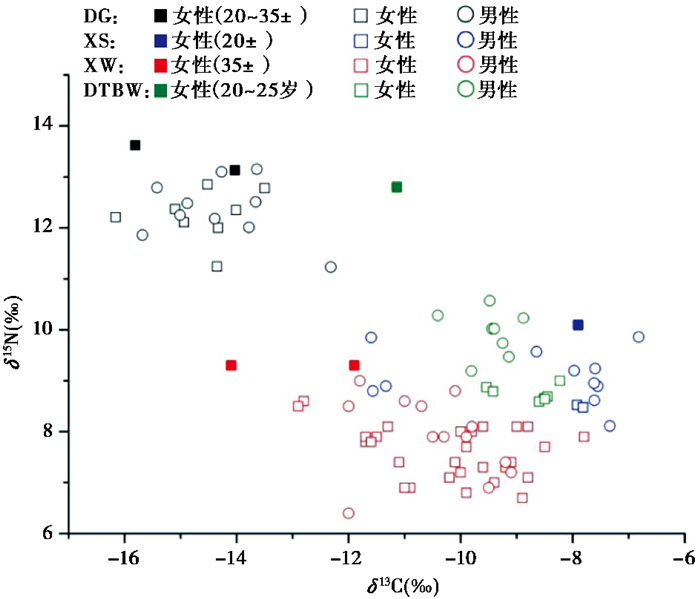
|
图 7 各考古遗址中同一年龄段不同性别个体的δ13C和δ15N值散点图 DG:多岗遗址[20];XS:西山遗址[87];XW:晓坞遗址[139];DTBW:大同南郊北魏墓群[16] Fig. 7 Scatter plot of δ13C and δ15N values of female and male bones from archaeological sites in China. Duogang(DG), Xishan(XS), Xiaowu(XW) and Northern Wei cemetery in Datong City(DTBW) |
此外,我国考古遗址出土与饮食相关的器具种类繁多,显示先民多样化的食物加工方式;其中,大量酒器与酒遗存的发现,表明我国丰富悠久的酒文化[60, 149~150]。青铜时代新疆洋海墓地发现大量大麻遗存,表明洋海先民可能吸食大麻[151]。已有研究表明,长时间烹煮将引起食物与酒水δ18O值的增加[52],进而导致消费者组织δ18O值的增加[33];长期吸烟也将促使人体组织的δ13C和δ15N值升高[152]。因此,稳定同位素分析对于我国古代食物加工技术、酒文化与宗教文化的研究具有潜在的应用价值。
3 结论与展望利用稳定同位素分析探索古代人类社会的发展已成为考古学研究的焦点之一。其中,如何将食谱分析更好的落足于解决考古学问题之上,还有待于对其理论方法的更深入探索。本文根据目前国内外有关稳定同位素食谱分析影响因素的研究现状,结合我国独具特色的饮食文化背景,通过对已有同位素数据的重新整理分析,探讨了我国古代食谱分析的影响因素。主要结论如下:
(1) 我国古代不同种属农作物因遗传因素与生理特征的不同,其组织的稳定同位素组成存在显著差异;同种农作物不同品种以及不同组织的稳定同位素组成也存在差异。这些差异将进一步影响不同取食者食谱的对比分析。另外,气候因子与地理环境可间接通过影响植物的稳定同位素组成或直接通过影响个体新陈代谢对人或动物组织的稳定同位素组成产生影响。
(2) 动、植物驯化之初,人类对其觅食行为、生长环境与生理过程进行干预,从而影响动、植物的稳定同位素组成。另外,人类各项农业活动(如灌溉、施肥等)或生产活动(工业燃料燃烧)通过改变植物生长条件影响其稳定同位素组成。
(3) 生物体自身生理与健康因素(如年龄、健康状况、特殊生理期、饮食习惯等)通过影响自身新陈代谢最终导致其组织的稳定同位素组成发生变化。
稳定同位素食谱分析影响因素的综合评估对于更准确全面的分析古代人(或动物)的食谱具有重要意义。与此同时,深入解析生物体稳定同位素组成的变化规律与影响因素之间的关系,又可为我国考古学、历史学、人类学等诸多领域提供一个新的研究视角。例如,不同时期农作物与家畜稳定同位素组成的变化规律可为探索动植物驯化机制以及古代农业技术发展提供重要依据;稳定同位素分析所反映的史前自然环境与人类生业模式可为历史地理学史前人地关系的研究打开新的视角;妊娠期女性组织特殊的稳定同位素组成可为判断我国古代女性生育年龄、营养水平、医疗健康以及人口增长速度等提供重要依据;古代特殊人群稳定同位素组成的变化规律,又可为历史自然灾害或大规模疾病突发以及应对政策的研究提供一定的依据;稳定同位素分析又成为我国古代食物加工技术以及饮食文化研究新的切入点,等等。此外,研究对象的多样化(如毛发、指甲、粪化石、牙结石等)以及多重同位素的分析(如S、Sr、Fe、Zn等)也将进一步扩展古食谱稳定同位素分析在多学科领域的应用。但与此同时,稳定同位素分馏机理与不同因素影响机制仍需更深入的研究,如不同埋藏环境下,成岩作用对考古遗址出土生物体组织稳定同位素组成的影响以及多因素共同作用下生物体不同组织稳定同位素的分馏机制等。
致谢: 非常感谢中国科学院古脊椎动物与古人类研究所胡耀武教授、陕西师范大学西北历史环境与经济社会发展研究院崔建新副研究员以及审稿专家和编辑对本文提出的宝贵意见。
| [1] |
Vogel J C, van der Merwe N J. Isotopic evidence for early maize cultivation in New York State[J]. American Antiquity, 1977, 42(2): 238-242. DOI:10.2307/278984 |
| [2] |
蔡莲珍, 仇士华. 碳十三测定和古代食谱研究[J]. 考古, 1984(10): 945-955. Cai Lianzhen, Qiu Shihua. 13C analysis and paleodiet reconstruction[J]. Archaeology, 1984(10): 945-955. |
| [3] |
Hu Yaowu, Shang Hong, Tong Haowen, et al. Stable isotope dietary analysis of the Tianyuan 1 early modern human[J]. Proceedings of the National Academy of Sciences of the United States of America, 2009, 106(27): 10971-10974. DOI:10.1073/pnas.0904826106 |
| [4] |
马姣, 张凤礼, 王元, 等. 稳定同位素示踪东北地区晚更新世真猛犸象的摄食行为[J]. 第四纪研究, 2017, 37(4): 885-894. Ma Jiao, Zhang Fengli, Wang Yuan, et al. Tracking the foraging behavior of Mammuthus primigenius from the Late Pleistocene of Northeast China, using stable isotope analysis[J]. Quaternary Sciences, 2017, 37(4): 885-894. |
| [5] |
Hu Yaowu, Wang Shougong, Luan Fengshi, et al. Stable isotope analysis of humans from Xiaojingshan site:Implications for understanding the origin of millet agriculture in China[J]. Journal of Archaeological Science, 2008, 35(11): 2960-2965. DOI:10.1016/j.jas.2008.06.002 |
| [6] |
Liu Xinyi, Jones M K, Zhao Zhijun, et al. The earliest evidence of millet as a staple crop:New light on Neolithic foodways in North China[J]. American Journal of Physical Anthropology, 2012, 149(2): 283-290. DOI:10.1002/ajpa.22127 |
| [7] |
司艺, 吕恩国, 李肖, 等. 新疆洋海墓地先民的食物结构及人群组成探索[J]. 科学通报, 2013, 58(15): 1422-1429. Si Yi, Lü Enguo, Li Xiao, et al. Human diets and population components at the Yanghai cemetery, Xinjiang[J]. Chinese Science Bulletin, 2013, 58(15): 1422-1429. |
| [8] |
Guo Yi, Fan Yilu, Hu Yaowu, et al. Diet transition or human migration in the Chinese Neolithic?Dietary and migration evidence from the stable isotope analysis of humans and animals from the Qinglongquan site, China[J]. International Journal of Osteoarchaeology, 2015, 504(1): 45-51. |
| [9] |
Wang Tingting, Wei Dong, Chang Xien, et al. Tianshanbeilu and the isotopic millet road:Reviewing the late Neolithic/Bronze Age radiation of human millet consumption from North China to Europe[J]. National Science Review, 2017. DOI:10.1093/nsr/nwx015 |
| [10] |
Qu Yating, Hu Yaowu, Rao Huiyun, et al. Diverse lifestyles and populations in the Xiaohe Culture of the Lop Nur region, Xinjiang, China[J]. Archaeological and Anthropological Sciences, 2018, 10(8): 2005-2014. DOI:10.1007/s12520-017-0520-7 |
| [11] |
Dong Yu, Morgan C, Chinenov Y, et al. Shifting diets and the rise of male-biased inequality on the central plains of China during eastern Zhou[J]. Proceedings of the National Academy of Sciences of the United States of America, 2017, 114(5): 932-937. DOI:10.1073/pnas.1611742114 |
| [12] |
Chen Xianglong, Hu Songmei, Hu Yaowu, et al. Raising practices of Neolithic livestock evidenced by stable isotope analysis in the Wei River valley, North China[J]. International Journal of Osteoarchaeology, 2016, 26(1): 42-52. DOI:10.1002/oa.2393 |
| [13] |
Qiu Zhenwei, Yang Yimin, Shang Xue, et al. Paleo-environment and paleo-diet inferred from early Bronze Age cow dung at Xiaohe Cemetery, Xinjiang, NW China[J]. Quaternary International, 2014, 349: 167-177. DOI:10.1016/j.quaint.2014.03.029 |
| [14] |
李大伟, 王頠, 胡超涌, 等. 广西陆那洞古人类遗址古环境背景研究[J]. 第四纪研究, 2017, 37(4): 877-884. Li Dawei, Wang Wei, Hu Chaoyong, et al. Paleoenvironment background research in Luna cave, Guangxi[J]. Quaternary Sciences, 2017, 37(4): 877-884. |
| [15] |
陈相龙, 郭小宁, 王炜林, 等. 陕北神圪垯墚遗址4000 a BP前后生业经济的稳定同位素记录[J]. 中国科学:地球科学, 2017, 60(1): 95-103. Chen Xianglong, Guo Xiaoning, Wang Weilin, et al. The subsistence patterns of the Shengedaliang site(~4, 000 yr BP)revealed by stable carbon and nitrogen isotopes in northern Shaanxi, China[J]. Science China:Earth Sciences, 2017, 60(2): 268-276. |
| [16] |
张国文, 胡耀武, 裴德明, 等. 大同南郊北魏墓群人骨的稳定同位素分析[J]. 南方文物, 2010(1): 127-131. Zhang Guowen, Hu Yaowu, Pei Deming, et al. Stable isotope analysis of human bones from the Northern Wei cemetery in Datong City[J]. Cultural Relics in Southern China, 2010(1): 127-131. DOI:10.3969/j.issn.1004-6275.2010.01.022 |
| [17] |
王芬, 宋艳波, 李宝硕, 等. 北阡遗址人和动物骨的C, N稳定同位素分析[J]. 中国科学:地球科学, 2014, 57(12): 2029-2036. Wang Fen, Song Yanbo, Li Baoshuo, et al. C and N stable isotope analysis of human and animal bones at the Beiqian site[J]. Science China:Earth Sciences, 2014, 57(3): 408-414. |
| [18] |
Hou Liangliang, Hu Yaowu, Zhao Xinping, et al. Human subsistence strategy at Liuzhuang site, Henan, China during the proto-Shang culture(~2000-1600 BC)by stable isotopic analysis[J]. Journal of Archaeological Science, 2013, 40(5): 2344-2351. DOI:10.1016/j.jas.2013.01.005 |
| [19] |
陈相龙, 方燕明, 胡耀武, 等. 稳定同位素分析对史前生业经济复杂化的启示:以河南禹州瓦店遗址为例[J]. 华夏考古, 2017(4): 70-79. Chen Xianglong, Fang Yanming, Hu Yaowu, et al. The enlightenment of stable isotope analysis on the complexity of prehistoric economy:A case study of Wadian site in Yuzhou, Henan Province[J]. Huaxia Archaeology, 2017(4): 70-79. |
| [20] |
张雪莲, 仇士华, 张君, 等. 新疆多岗墓地出土人骨的碳氮稳定同位素分析[J]. 南方文物, 2014(3): 79-91. Zhang Xuelian, Qiu Shihua, Zhang Jun, et al. C and N stable isotope analysis of human bones from Duogang cemetery in Xinjiang[J]. Cultural Relics in Southern China, 2014(3): 79-91. DOI:10.3969/j.issn.1004-6275.2014.03.016 |
| [21] |
Ma Ying, Fuller B T, Wei Dong, et al. Isotopic perspectives(δ13C, δ15N, δ34 S)of diet, social complexity, and animal husbandry during the proto-Shang period(ca. 2000-1600BC) of China[J]. American Journal of Physical Anthropology, 2016, 160(3): 433-445. DOI:10.1002/ajpa.22980 |
| [22] |
Hu Yaowu, Ambrose S H, Wang Changsui. Stable isotopic analysis of human bones from Jiahu site, Henan, China:Implications for the transition to agriculture[J]. Journal of Archaeological Science, 2006, 33(9): 1319-30. DOI:10.1016/j.jas.2006.01.007 |
| [23] |
尹若春, 张居中, 杨晓勇. 贾湖史前人类迁移行为的初步研究——锶同位素分析技术在考古学中的运用[J]. 第四纪研究, 2008, 28(1): 50-57. Yin Ruochun, Zhang Juzhong, Yang Xiaoyong. Preliminary study on human migration at the Jiahu site:The application of Sr isotope analysis in archaeology[J]. Quaternary Sciences, 2008, 28(1): 50-57. DOI:10.3321/j.issn:1001-7410.2008.01.006 |
| [24] |
张国文, 胡耀武, Nehlich Olaf, 等. 关中两汉先民生业模式及与北方游牧民族间差异的稳定同位素分析[J]. 华夏考古, 2013(3): 131-141. Zhang Guowen, Hu Yaowu, Nehlich Olaf, et al. Stable isotope analysis of the subsistence modes of the Han Nationality in Guanzhong region and the northern nomads[J]. Huaxia Archaeology, 2013(3): 131-141. |
| [25] |
Bogaard A, Fraser R, Heaton T H E, et al. Crop manuring and intensive land management by Europe's first farmers[J]. Proceedings of the National Academy of Sciences of the United States of America, 2013, 110(31): 12589-12594. DOI:10.1073/pnas.1305918110 |
| [26] |
Schutkowski H, Herrmann B, Wiedemann F, et al. Diet, status and decomposition at Weingarten:Trace element and isotope analyses on early mediaeval skeletal material[J]. Journal of Archaeological Science, 1999, 26(6): 675-685. DOI:10.1006/jasc.1998.0384 |
| [27] |
Stantis C, Kinaston R L, Richards M P, et al. Assessing human diet and movement in the Tongan maritime chiefdom using isotopic analyses[J]. PLoS ONE, 2015, 10(3): e0123156. DOI:10.1371/journal.pone.0123156 |
| [28] |
Prowse T L, Schwarcz H P, Garnsey P, et al. Isotopic evidence for age-related immigration to imperial Rome[J]. American Journal of Physical Anthropology, 2007, 132(4): 510-519. DOI:10.1002/ajpa.20541 |
| [29] |
Reynard L M, Tuross N. The known, the unknown and the unknowable:Weaning times from archaeological bones using nitrogen isotope ratios[J]. Journal of Archaeological Science, 2015, 53: 618-625. DOI:10.1016/j.jas.2014.11.018 |
| [30] |
White C D, Armelagos G J. Osteopenia and stable isotope ratios in bone collagen of Nubian female mummies[J]. American Journal of Physical Anthropology, 1997, 103(2): 185-199. |
| [31] |
Fuller B T, Fuller J L, Sage N E, et al. Nitrogen balance and δ15N:Why you're not what you eat during nutritional stress[J]. Rapid Communications in Mass Spectrometry, 2005, 19(18): 2497-2506. DOI:10.1002/rcm.2090 |
| [32] |
Beaumont J, Montgomery J. The Great Irish Famine:Identifying starvation in the tissues of victims using stable isotope analysis of bone and incremental dentine collagen[J]. PLoS ONE, 2016, 11(8): e0160065. DOI:10.1371/journal.pone.0160065 |
| [33] |
Lamb A L, Evans J E, Buckley R, et al. Multi-isotope analysis demonstrates significant lifestyle changes in King Richard Ⅲ[J]. American Journal of Physical Anthropology, 2014, 50: 559-565. |
| [34] |
Pollard A M, Ditchfield P, Piva E, et al. 'sprouting like cockle amongst the wheat':The St Brice's Day Massacre and the isotopic analysis of human bones from St John's College, Oxford[J]. Oxford Journal of Archaeology, 2012, 31(1): 83-102. |
| [35] |
Schwarcz H P, White C D. The grasshopper or the ant?:Cultigen-use strategies in ancient Nubia from C-13 analyses of human hair[J]. Journal of Archaeological Science, 2004, 31(6): 753-762. DOI:10.1016/j.jas.2003.11.004 |
| [36] |
Grant J, Mondini M, Panarello H O. Carbon and nitrogen isotopic ecology of Holocene camelids in the Southern Puna(Antofagasta de la Sierra, Catamarca, Argentina):Archaeological and environmental implications[J]. Journal of Archaeological Science:Reports, 2018, 18: 637-647. DOI:10.1016/j.jasrep.2017.05.045 |
| [37] |
Gil A F, Villalba R, Ugan A, et al. Isotopic evidence on human bone for declining maize consumption during the little ice age in central western Argentina[J]. Journal of Archaeological Science, 2014, 49: 213-227. DOI:10.1016/j.jas.2014.05.009 |
| [38] |
van der Merwe N J. Natural variation in 13C concentration and its effect on environmental reconstruction using 13C/12C ratios in animal bones[M]//Price D. Bone Chemistry and Past Behavior. School of American Research Advanced Seminar Series. Cambridge: Cambridge University Press, 1989: 105-125.
|
| [39] |
Marino B D, McElroy M B. Isotopic composition of atmospheric CO2 inferred from carbon in C4 plant cellulose[J]. Nature, 1991, 349: 127-131. DOI:10.1038/349127a0 |
| [40] |
Tieszen L L, Fagre T. Effect of diet quality and composition on the isotopic composition of respiratory CO2, bone collagen, bioapatite, and soft tissues[M]//Lambert J B, Grupe G. Prehistoric Human Bone. Berlin: Springer Berlin Heidelberg, 1993: 121-155.
|
| [41] |
Fraser I, Meieraugenstein W, Kalin R M. Stable isotope analysis of human hair and nail samples:the effects of storage on samples[J]. Journal of Forensic Sciences, 2008, 53(1): 95-99. |
| [42] |
An Chengbang, Dong Weimiao, Li Hu, et al. Variability of the stable carbon isotope ratio in modern and archaeological millets:Evidence from Northern China[J]. Journal of Archaeological Science, 2015, 53: 316-322. DOI:10.1016/j.jas.2014.11.001 |
| [43] |
An Chengbang, Dong Weimiao, Chen Yufeng, et al. Stable isotopic investigations of modern and charred foxtail millet and the implications for environmental archaeological reconstruction in the western Chinese Loess Plateau[J]. Quaternary Research, 2015, 84(1): 144-149. |
| [44] |
杨青, 李小强. 黄土高原地区粟、黍碳同位素特征及其影响因素研究[J]. 中国科学(地球科学), 2015, 58(11): 1683-1697. Yang Qing, Li Xiaoqiang. Investigation of the controlled factors influencing carbon isotope composition of foxtail and common millet on the Chinese Loess Plateau[J]. Science China:Earth Sciences, 2015, 58(12): 2296-2308. |
| [45] |
Wang Xin, Fuller B T, Zhang Pengcheng, et al. Millet manuring as a driving force for the late Neolithic agricultural expansion of North China[J]. Scientific Reports, 2018, 8: 5552. DOI:10.1038/s41598-018-23315-4 |
| [46] |
尹粟, 李恩山, 王婷婷, 等. 我即我食vs.我非我食——稳定同位素示踪人体代谢异常初探[J]. 第四纪研究, 2017, 37(6): 1464-1471. Yin Su, Li Enshan, Wang Tingting, et al. You are what you eat vs. you are not what you eat-Tracing human metabolism abnormality by stable isotopic analysis[J]. Quaternary Sciences, 2017, 37(6): 1464-1471. |
| [47] |
Xia Yang, Zhang Jinglei, Yu Fei, et al. Breastfeeding, weaning, and dietary practices during the Western Zhou Dynasty(1122-771 BC)at Boyangcheng, Anhui Province, China[J]. American Journal of Physical Anthropology, 2018, 165(2): 343-352. |
| [48] |
Yi Bing, Liu Xiangyu, Yuan Haibing, et al. Dentin isotopic reconstruction of individual life histories reveals millet consumption during weaning and childhood at the late Neolithic(4500 BP)Gaoshan site in Southwestern China[J]. International Journal of Osteoarchaeology, 2018, 28(6): 636-644. DOI:10.1002/oa.2676 |
| [49] |
陈相龙, 罗运兵, 胡耀武, 等. 青龙泉遗址随葬猪牲的C、N稳定同位素分析[J]. 江汉考古, 2015(5): 107-115. Chen Xianglong, Luo Yunbing, Hu Yaowu, et al. Stable isotope analysis(C, N)of pig sacrifices at the Qinglongquan site[J]. Jianghan Archaeology, 2015(5): 107-115. |
| [50] |
Kohn M J. You are what you eat[J]. Science, 1999, 283(5400): 335-336. DOI:10.1126/science.283.5400.335 |
| [51] |
Hare P E, Fogel M L, Jr T W S, et al. The isotopic composition of carbon and nitrogen in individual amino acids isolated from modern and fossil proteins[J]. Journal of Archaeological Science, 1991, 18(3): 277-292. DOI:10.1016/0305-4403(91)90066-X |
| [52] |
Brettell R, Montgomery J, Evans J. Brewing and stewing:The effect of culturally mediated behaviour on the oxygen isotope composition of ingested fluids and the implications for human provenance studies[J]. Journal of Analytical Atomic Spectrometry, 2012, 27: 778-785. DOI:10.1039/c2ja10335d |
| [53] |
Zhao Zhijun. New archaeobotanic data for the study of the origins of agriculture in China[J]. Current Anthropology, 2011, 52(S4): S295-S306. DOI:10.1086/659308 |
| [54] |
Yang Xiaoyan, Wan Zhiwei, Perry L, et al. Early millet use in Northern China[J]. Proceedings of the National Academy of Sciences of the United States of America, 2012, 109(10): 3726-3730. DOI:10.1073/pnas.1115430109 |
| [55] |
Wu Yan, Jiang Leping, Zheng Yunfei, et al. Morphological trend analysis of rice phytolith during the early Neolithic in the lower Yangtze[J]. Journal of Archaeological Science, 2014, 49: 326-331. DOI:10.1016/j.jas.2014.06.001 |
| [56] |
Zuo Xinxin, Lu Houyuan, Jiang Leping, et al. Dating rice remains through phytolith carbon-14 study reveals domestication at the beginning of the Holocene[J]. Proceedings of the National Academy of Sciences of the United States of America, 2017, 114(25): 6486-6491. DOI:10.1073/pnas.1704304114 |
| [57] |
杨玉璋, 禤华丽, 袁增箭, 等. 安徽繁昌缪墩遗址古人类植物性食物资源利用的淀粉粒分析[J]. 第四纪研究, 2016, 36(6): 1466-1474. Yang Yuzhang, Xuan Huali, Yuan Zengjian, et al. Utilization of plant food resources at Miudun site in Anhui Province based on starch grain analysis[J]. Quaternary Sciences, 2016, 36(6): 1466-1474. |
| [58] |
赵春燕, 赵志军. 河南二里头遗址出土陶容器内残留物的碳氮稳定同位素分析[J]. 第四纪研究, 2018, 38(6): 1424-1430. Zhao Chunyan, Zhao Zhijun. Stable isotopic analyses of residues on the interiors of ceramics from Erlitou site in Henan Province[J]. Quaternary Sciences, 2018, 38(6): 1424-1430. |
| [59] |
王灿, 吕厚远, 顾万发, 等. 全新世中期郑州地区古代农业的时空演变及其影响因素[J]. 第四纪研究, 2019, 39(1): 108-122. Wang Can, Lü Houyuan, Gu Wanfa, et al. Spatial-temporal evolution of agriculture and factors influencing it during the mid-Holocene in Zhengzhou area, China[J]. Quaternary Sciences, 2019, 39(1): 108-122. |
| [60] |
王巍. 中国考古学大辞典[M]. 上海: 上海辞书出版社, 2014: 1-478. Wang Wei. Archaeological Dictionary of China[M]. Shanghai: Shanghai Lexicographic Publishing House, 2014: 1-478. |
| [61] |
孙亚男, 杨玉璋, 张家强, 等. 郑州地区东赵先民植物性食物结构及遗址出土部分陶器功能分析:来自植物淀粉粒的证据[J]. 第四纪研究, 2018, 38(2): 406-419. Sun Yanan, Yang Yuzhang, Zhang Jiaqiang, et al. Starch grains evidence reveals human's plant food structure and pottery function at Dongzhao site in Zhengzhou City, Henan Province[J]. Quaternary Sciences, 2018, 38(2): 406-419. |
| [62] |
马志坤, 郇秀佳, 马永超, 等. 古代淀粉遗存反映的新石器中期华北平原北部旱作农业发展状况——以河北阳原姜家梁遗址为例[J]. 第四纪研究, 2018, 38(5): 1313-1324. Ma Zhikun, Huan Xiujia, Ma Yongchao, et al. Ancient starch reveals millet farming in northern part of the North China Plain during mid-term Neolithic Period:A case study of the Jiangjialiang site[J]. Quaternary Sciences, 2018, 38(5): 1313-1324. |
| [63] |
崔启龙, 张居中, 杨晓勇, 等. 河南舞阳贾湖遗址石制品资源域研究以及意义[J]. 第四纪研究, 2017, 37(3): 486-497. Cui Qilong, Zhang Juzhong, Yang Xiaoyong, et al. The study and significance of stone artifact resource catchments in the Jiahu site, Wuyang, Henan Province[J]. Quaternary Sciences, 2017, 37(3): 486-497. |
| [64] |
Berry J A. Studies of mechanisms affecting the fractionation of carbon isotopes in photosynthesis[M]//Rundel P W, Ehleringer J R, Nagy K A. Stable Isotope in Ecological Research. New York: Springer-Verlag, 1989: 82-94.
|
| [65] |
刘贤赵, 王国安, 李嘉竹, 等. 北京东灵山地区现代植物氮同位素组成及其对海拔梯度的响应[J]. 中国科学(D辑:地球科学), 2010, 53(10): 1347-1359. Liu Xianzhao, Wang Guo'an, Li Jiazhu, et al. Nitrogen isotope composition characteristics of modern plants and their variations along an altitudinal gradient in Dongling Mountain in Beijing[J]. Science in China(Series D:Earth Sciences), 2010, 53(1): 128-140. |
| [66] |
Codron J, Codron D, Lee-Thorp J A, et al. Taxonomic, anatomical, and spatio-temporal variations in the stable carbon and nitrogen isotopic compositions of plants from an African savanna[J]. Journal of Archaeological Science, 2005, 32(12): 1757-1772. DOI:10.1016/j.jas.2005.06.006 |
| [67] |
刘金亮, 尹希杰, 濮鸿雪, 等. 大九湖泥炭地现代植物不同组分的δ18O特征及其古气候意义[J]. 第四纪研究, 2018, 38(4): 1024-1034. Liu Jinliang, Yin Xijie, Pu Hongxue, et al. Characteristics of δ18O of the different components of plants and it's climatic significance in the Dajiuhu peatbog, Central China[J]. Quaternary Sciences, 2018, 38(4): 1024-1034. |
| [68] |
Levin N E, Quade J, Simpson S W, et al. Isotopic evidence for Plio-Pleistocene environmental change at Gona, Ethiopia[J]. Earth and Planetary Science Letters, 2004, 219(1-2): 93-110. DOI:10.1016/S0012-821X(03)00707-6 |
| [69] |
Liu Weiguo, Wang Zheng. Nitrogen isotopic composition of plant-soil in the Loess Plateau and its responding to environmental change[J]. Chinese Science Bulletin, 2009, 54(2): 272-279. |
| [70] |
Weigt R B, Streit K, Saurer M, et al. The influence of increasing temperature and CO2 concentration on recent growth of old-growth larch:Contrasting responses at leaf and stem processes derived from tree-ring width and stable isotopes[J]. Tree Physiology, 2018, 38(5): 706-720. DOI:10.1093/treephys/tpx148 |
| [71] |
史江峰, 史逝远, 马晓琦, 等. 我国东南和华北季风区树轮气候和环境变化研究进展[J]. 第四纪研究, 2018, 38(6): 1471-1486. Shi Jiangfeng, Shi Shiyuan, Ma Xiaoqi, et al. Progress of tree-ring studies in climate and environment in Southeast China and North China[J]. Quaternary Sciences, 2018, 38(6): 1471-1486. |
| [72] |
赵志军. 中国古代农业的形成过程——浮选出土植物遗存证据[J]. 第四纪研究, 2014, 34(1): 73-84. Zhao Zhijun. The process of origin of agriculture in China:Archaeological evidence from flotation results[J]. Quaternary Sciences, 2014, 34(1): 73-84. DOI:10.3969/j.issn.1001-7410.2014.01.10 |
| [73] |
Long Tengwen, Leipe C, Jin Guiyun, et al. The early history of wheat in China from 14C dating and Bayesian chronological modelling[J]. Nature Plants, 2018, 4: 272-279. DOI:10.1038/s41477-018-0141-x |
| [74] |
郭荣臻, 靳桂云. 先秦时期海岱地区的麦作农业[J]. 第四纪研究, 2019, 39(1): 144-160. Guo Rongzhen, Jin Guiyun. Study on the wheat agriculture in the pre-Qin period of Haidai region[J]. Quaternary Sciences, 2019, 39(1): 144-160. |
| [75] |
Liu Xinyi, Lightfoot E, O'Connell T C, et al. From necessity to choice:Dietary revolutions in West China in the second millennium BC[J]. World Archaeology, 2014, 46(5): 661-680. DOI:10.1080/00438243.2014.953706 |
| [76] |
Ma Minmin, Dong Guanghui, Jia Xin, et al. Dietary shift after 3600 cal yr BP and its influencing factors in Northwestern China:Evidence from stable isotopes[J]. Quaternary Science Reviews, 2016, 145: 57-70. DOI:10.1016/j.quascirev.2016.05.041 |
| [77] |
屈亚婷, 胡珂, 杨苗苗, 等. 新石器时代关中地区人类生业模式演变的生物考古学证据[J]. 人类学学报, 2017, 36(3): 1-14. Qu Yating, Hu Ke, Yang Miaomiao, et al. Biological evidence for human subsistence strategy in the Guanzhong area during the Neolithic Period[J]. Acta Anthropologica Sinica, 2017, 36(3): 202-215. |
| [78] |
Pechenkina E A, Ambrose S H, Ma Xiaolin, et al. Reconstructing northern Chinese Neolithic subsistence practices by isotopic analysis[J]. Journal of Archaeology Science, 2005, 32(8): 1176-1189. DOI:10.1016/j.jas.2005.02.015 |
| [79] |
Korenaga T, Musashi M, Nakashita R, et al. Statistical analysis of rice samples for compositions of multiple light elements(H, C, N, and O)and their stable isotopes[J]. Analytical Sciences, 2010, 26(8): 873-878. DOI:10.2116/analsci.26.873 |
| [80] |
Gupta N S, Leng Qin, Yang Hong, et al. Molecular preservation and bulk isotopic signals of ancient rice from the Neolithic Tianluoshan site, lower Yangtze River valley, China[J]. Organic Geochemistry, 2013, 63: 85-93. DOI:10.1016/j.orggeochem.2013.08.006 |
| [81] |
刘宏艳, 郭波莉, 魏帅, 等. 小麦制粉产品稳定碳、氮同位素组成特征[J]. 中国农业科学, 2017, 50(3): 556-563. Liu Hongyan, Guo Boli, Wei Shuai, et al. Characteristics of stable carbon and nitrogen isotopic ratios in wheat milling fractions[J]. Scientia Agricultura Sinica, 2017, 50(3): 556-563. |
| [82] |
刘长江, 靳桂云, 孔昭宸. 植物考古:种子和果实研究[M]. 北京: 科学出版社, 2008: 160-201. Liu Changjiang, Jin Guiyun, Kong Zhaochen. Paleoethnobotany:Seeds and Fruits Researches[M]. Beijing: Science Press, 2008: 160-201. |
| [83] |
陈亭亭, 贾鑫, 黎海明, 等. 甘青地区齐家文化时期农业结构的时空变化及其影响因素分析[J]. 第四纪研究, 2019, 39(1): 132-143. Chen Tingting, Jia Xin, Li Haiming, et al. The analysis of spatiotemporal transformations of agricultural and its influence factors during Qijia culture period in Gansu-Qinghai region[J]. Quaternary Sciences, 2019, 39(1): 132-143. |
| [84] |
Yoneyama T, Handley L L, Scrimgeour C M, et al. Variations of the natural abundances of nitrogen and carbon isotopes in Triticum aestivum, with special reference to phloem and xylem exudates[J]. New Phytologist, 1997, 137(2): 205-213. DOI:10.1046/j.1469-8137.1997.00809.x |
| [85] |
Winkler F J, Wirth E, Latzko E, et al. Influence of growth conditions and development on δ13C values in different organs and constituents of wheat, oat and maize[J]. Journal of Plant Physiology, 1978, 87(3): 255-263. |
| [86] |
李发林. 古代旋转磨试探[J]. 农业考古, 1986(2): 146-167. Li Falin. Preliminary exploration of the ancient rotary grinding[J]. Agricultural Archaeology, 1986(2): 146-167. |
| [87] |
张雪莲, 仇士华, 钟建, 等. 中原地区几处仰韶文化时期考古遗址的人类食物状况分析[J]. 人类学学报, 2010, 29(2): 197-207. Zhang Xuelian, Qiu Shihua, Zhong Jian, et al. Human diets at several archaeological sites in Central Plain during the Yangshao Culture[J]. Acta Anthropologica Sinica, 2010, 29(2): 197-207. |
| [88] |
Cormie A P, Schwarcz H P. Effects of climate on deer bone δ15N and δ13C:Lack of precipitation effects on δ15N for animals consuming low amounts of C4 plants[J]. Geochimica et Cosmochimica Acta, 1996, 60(21): 4161-4166. DOI:10.1016/S0016-7037(96)00251-7 |
| [89] |
Gannes L Z, Martínez del Rio C, Koch P. Natural abundance variations in stable isotopes and their potential uses in animal physiological ecology[J]. Comparative Biochemistry and Physiology part A:Molecular & Integrative Physiology, 1998, 119(3): 725-737. |
| [90] |
Yang Qing, Li Xiaoqiang, Liu Weiguo, et al. Carbon isotope fractionation during low temperature carbonization of foxtail and common millets[J]. Organic Geochemistry, 2011, 42(7): 713-719. DOI:10.1016/j.orggeochem.2011.06.012 |
| [91] |
郭怡, 项晨, 夏阳, 等. 中国南方古人骨中羟磷灰石稳定同位素分析的可行性初探——以浙江省庄桥坟遗址为例[J]. 第四纪研究, 2017, 37(1): 143-154. Guo Yi, Xiang Chen, Xia Yang, et al. Preliminary study on the feasibility of hydroxyapatite stable isotope analysis of ancient human bone in South China:Take the Zhuangqiaofen site, Zhejiang Province as an example[J]. Quaternary Sciences, 2017, 37(1): 143-154. |
| [92] |
陈相龙, 袁靖, 胡耀武, 等. 陶寺遗址家畜饲养策略初探:来自碳、氮稳定同位素的证据[J]. 考古, 2012, 540(9): 75-82. Chen Xianglong, Yuan Jing, Hu Yaowu, et al. Preliminary exploration of feeding strategies of domestic animal at the Taosi site:Evidence of carbon and nitrogen stable isotopes[J]. Archaeology, 2012, 540(9): 75-82. |
| [93] |
田晓四, 朱诚, 孙智彬, 等. 长江三峡库区中坝遗址哺乳动物骨骼化石C和N稳定同位素分析[J]. 科学通报, 2011, 56(34): 3310-3319. Tian Xiaosi, Zhu Cheng, Sun Zhibin, et al. Carbon and nitrogen stable isotope analyses of mammal bone fossils from the Zhongba site in the Three Gorges Reservoir region of the Yangtze River, China[J]. Chinese Science Bulletin, 2011, 56(2): 169-178. |
| [94] |
李金玉. 刀耕火种对周代生态环境的影响[J]. 农业考古, 2013(3): 93-96. Li Jinyu. The effects of slash-and-burn cultivation on the ecological environment of Zhou Dynasty[J]. Agricultural Archaeology, 2013(3): 93-96. |
| [95] |
王通洋, 龚德才, 田小红, 等. 新疆石城子遗址古代人类活动对土壤化学性质的影响[J]. 土壤通报, 2018, 49(1): 99-104. Wang Tongyang, Gong Decai, Tian Xiaohong, et al. Impact of human activities on the properties of Paleosolin Shichengzi Sites, Xinjiang Province[J]. Chinese Journal of Soil Science, 2018, 49(1): 99-104. |
| [96] |
Arroyo-Kalin M. Slash-burn-and-churn:Landscape history and crop cultivation in pre-Columbian Amazonia[J]. Quaternary International, 2012, 249: 4-18. DOI:10.1016/j.quaint.2011.08.004 |
| [97] |
de Rouw A, Soulileuth B, Huon S. Stable carbon isotope ratios in soil and vegetation shift with cultivation practices(Northern Laos)[J]. Agriculture, Ecosystems and Environment, 2015, 200: 161-168. DOI:10.1016/j.agee.2014.11.017 |
| [98] |
Wang Guo'an, Han Jiamao, Zhou Liping, et al. Carbon isotope ratios of C4 plants in loess areas of North China[J]. Science in China(Series D), 2006, 49(1): 97-102. DOI:10.1007/s11430-004-5238-6 |
| [99] |
袁靖. 中国动物考古学[M]. 北京: 文物出版社, 2015: 88-103. Yuan jing. Zooarchaeology of China[M]. Beijing: Cultural Relics Press, 2015: 88-103. |
| [100] |
Adams T S, Sterner R W. The effect of dietary nitrogen content on trophic level 15 N enrichment[J]. Limnology and Oceanography, 2000, 45(3): 601-607. DOI:10.4319/lo.2000.45.3.0601 |
| [101] |
Hobson K A, Alisauskas R T, Clark R G. Stable nitrogen isotope enrichment in avian tissue due to fasting and nutritional stress:Implication for isotopic analyses of diet[J]. The Condor, 1993, 95(2): 388-394. DOI:10.2307/1369361 |
| [102] |
Cherel Y, Hobson K A, Bailleul F, et al. Nutrition, physiology, and stable isotopes:New information from fasting and molting penguins[J]. Ecology, 2005, 86(11): 2881-2888. DOI:10.1890/05-0562 |
| [103] |
陈文华. 农业考古[M]. 北京: 文物出版社, 2002: 1-205. Chen Wenhua. Agricultural Archaeology[M]. Beijing: Cultural Relics Press, 2002: 1-205. |
| [104] |
管理, 胡耀武, 汤卓炜, 等. 通化万发拨子遗址猪骨的C, N稳定同位素分析[J]. 科学通报, 2007, 52(14): 1678-1680. Guan Li, Hu Yaowu, Tang Zhuowei, et al. Stable isotopic analysis on Sus bones from the Wanfabozi site, Tonghua, Jilin[J]. Chinese Science Bulletin, 2007, 52(24): 3393-3396. |
| [105] |
Barton L, Newsome S D, Chen Fahu, et al. Agricultural origins and the isotopic identity of domestication in Northern China[J]. Proceedings of the National Academy of Sciences of the United States of America, 2009, 106(14): 5523-5528. DOI:10.1073/pnas.0809960106 |
| [106] |
Atahan P, Dodson J, Li Xiaoqiang, et al. Early Neolithic diets at Baijia, Wei River Valley, China:Stable carbon and nitrogen isotope analysis of human and faunal remains[J]. Journal of Archaeology Science, 2011, 38(10): 2811-2817. DOI:10.1016/j.jas.2011.06.032 |
| [107] |
Hu Yaowu, Hu Songmei, Wang Weilin, et al. Earliest evidence for commensal processes of cat domestication[J]. Proceedings of the National Academy of Sciences of the United States of America, 2014, 111(1): 116-120. DOI:10.1073/pnas.1311439110 |
| [108] |
胡耀武, 栾丰实, 王守功, 等. 利用C, N稳定同位素分析法鉴别家猪与野猪的初步尝试[J]. 中国科学(D辑), 2009, 52(6): 693-700. Hu Yaowu, Luan Fengshi, Wang Shougong, et al. Preliminary attempt to distinguish the domesticated pigs from wild boars by the methods of carbon and nitrogen stable isotope analysis[J]. Science in China(Series D), 2009, 52(1): 85-92. |
| [109] |
张全超, 汤卓炜, 王立新, 等. 吉林白城双塔遗址一期动物骨骼的稳定同位素分析[J]. 边疆考古研究, 2012(1): 355-360. Zhang Quanchao, Tang Zhuowei, Wang Lixin, et al. Stable isotopic analysis on animal bones from period I of Shuangta site, Baicheng, Jilin Province[J]. Research of China's Frontier Archaeology, 2012(1): 355-360. |
| [110] |
Amundson R, Austin A T, Schuur E A G, et al. Global patterns of the isotopic composition of soil and plant nitrogen[J]. Global Biogeochemical Cycles, 2003, 17(1): 1031. |
| [111] |
Choi W-J, Chang S X, Allen H L, et al. Irrigation and fertilization effects on foliar and soil carbon and nitrogen isotope ratios in a loblolly pine stand[J]. Forest Ecology and Management, 2005, 213(1-3): 90-101. DOI:10.1016/j.foreco.2005.03.016 |
| [112] |
Araus J L, Febrero A, Buxó R, et al. Identification of ancient irrigation practices based on the carbon isotope discrimination of plant seeds: A case study from the South-East Iberian Peninsula[J]. Journal of Archaeological Science, 1997, 24(8): 729-740. DOI:10.1006/jasc.1997.0154 |
| [113] |
Gómez-Alonso S, García-Romero E. Effect of irrigation and variety on oxygen(δ 18 O)and carbon(δ13C)stable isotope composition of grapes cultivated in a warm climate[J]. Australian Journal of Grape and Wine Research, 2010, 16(2): 283-289. |
| [114] |
Bateman A S, Kelly S D, Jickells T D. Nitrogen isotope relationships between crops and fertilizer:Implications for using nitrogen isotope analysis as an indicator of agricultural regime[J]. Journal of Agricultural and Food Chemistry, 2005, 53(14): 5760-5765. DOI:10.1021/jf050374h |
| [115] |
顾浩, 陈茂山. 古代中国的灌溉文明[J]. 中国农村水利水电, 2008(8): 1-8. Gu Hao, Chen Maoshan. Irrigation civilizations in ancient China[J]. China Rural Water and Hydropower, 2008(8): 1-8. |
| [116] |
王双怀. 中国古代灌溉工程的营造法式[J]. 陕西师范大学学报(哲学社会科学版), 2012, 41(4): 41-47. Wang Shuanghuai. Constructive models of irrigation projects in ancient China[J]. Journal of Shaanxi Normal University(Philosophy and Social Sciences Edition), 2012, 41(4): 41-47. |
| [117] |
高建飞, 丁悌平, 罗续荣, 等. 黄河水氢、氧同位素组成的空间变化特征及其环境意义[J]. 地质学报, 2011, 85(4): 596-602. Gao Jianfei, Ding Tiping, Luo Xurong, et al. δD and δ 18 O variations of water in the Yellow River and its environmental significance[J]. Acta Geologica Sinica, 2011, 85(4): 596-602. |
| [118] |
Luz B, Kolodny Y. Oxygen isotope variations in phosphate of biogenic apatites, Ⅳ. Mammal teeth and bones[J]. Earth and Planetary Science Letters, 1985, 75(1): 29-36. DOI:10.1016/0012-821X(85)90047-0 |
| [119] |
王宁, 李素婷, 李宏飞, 等. 古骨胶原的氧同位素分析及其在先民迁徙研究中的应用[J]. 科学通报, 2015, 60(9): 838-846. Wang Ning, Li Suting, Li Hongfei, et al. Oxygen isotope analysis of ancient bone collagen and its application in the study of human migration[J]. Chinese Science Bulletin, 2015, 60(9): 838-846. |
| [120] |
司艺, 李志鹏, 胡耀武, 等. 河南偃师二里头遗址动物骨胶原的H、O稳定同位素分析[J]. 第四纪研究, 2014, 34(1): 196-203. Si Yi, Li Zhipeng, Hu Yaowu, et al. Hydrogen and oxygen stable isotopic analysis of animal bone collagen from Erlitou site, Yanshi, Henan Province[J]. Quaternary Sciences, 2014, 34(1): 196-203. DOI:10.3969/j.issn.1001-7410.2014.01.23 |
| [121] |
竺可桢. 中国近五千年来气候变迁的初步研究[J]. 中国科学(A辑), 1973(2): 168-189. Chu Cochen. A preliminary study on climatic changes in China during the past 5, 000 years[J]. Science in China(Series A), 1973(2): 168-189. |
| [122] |
李满洲, 高淑琴, 李贶家. 河南平原第四系地下水氢氧同位素特征与补给分析[J]. 工程勘察, 2010, 38(11): 42-47. Li Manzhou, Gao Shuqin, Li Kuangjia. Features of hydrogen and oxygen isotopes of quaternary groundwater in Henan Plain and the recharge analysis[J]. Geotechnical Investigation & Surveying, 2010, 38(11): 42-47. |
| [123] |
张应桥. 试论夏商城市水利设施及其功能[J]. 华夏考古, 2006(1): 41-47. Zhang Yingqiao. Preliminary exploration of urban water conservancy facilities and their functions in Xia and Shang dynasties[J]. Huaxia Archaeology, 2006(1): 41-47. DOI:10.3969/j.issn.1001-9928.2006.01.007 |
| [124] |
Lim S S, Choi W J, Kwak J H, et al. Nitrogen and carbon isotope responses of Chinese cabbage and chrysanthemum to the application of liquid pig manure[J]. Plant Soil, 2007, 295(2): 67-77. |
| [125] |
谭黎明, 谭佳远. 古代农田施肥理论的研究[J]. 安徽农业科学, 2014, 42(21): 7296-7297. Tan Liming, Tan Jiayuan. Theoretical study of ancient farmland fertilization[J]. Journal of Anhui Agricultural Sciences, 2014, 42(21): 7296-7297. DOI:10.3969/j.issn.0517-6611.2014.21.145 |
| [126] |
慈恩, 杨林章, 倪九派, 等. 不同区域水稻土的氮素分配及δ15N特征[J]. 水土保持学报, 2009, 23(2): 103-108. Ci En, Yang Linzhang, Ni Jiupai, et al. Distribution and δ15N character of nitrogen in paddy soils located in different regions[J]. Journal of Soil and Water Conservation, 2009, 23(2): 103-108. DOI:10.3321/j.issn:1009-2242.2009.02.023 |
| [127] |
王国安, 韩家懋, 刘东生. 中国北方黄土区C-3草本植物碳同位素组成研究[J]. 中国科学(D辑), 2003, 33(6): 550-556. Wang Guo'an, Han Jiamao, Liu Dongsheng. Carbon isotope ratios of C-3 plants in loess areas of North China[J]. Science in China(Series D), 2003, 33(6): 550-556. |
| [128] |
Solga A, Burkhardt J, Frahm J P. A new approach to assess atmospheric nitrogen deposition by way of standardized exposition of mosses[J]. Environmental Monitoring & Assessment, 2006, 116(1-3): 399-417. |
| [129] |
Bassirirad H, Constable J V H, Lussenhop J, et al. Widespread foliage δ15N depletion under elevated CO2:Inferences for the nitrogen cycle[J]. Global Change Biology, 2010, 9(11): 1582-1590. |
| [130] |
Horz H P, Barbrook A, Field C B, et al. Ammonia-oxidizing bacteria respond to multifactorial global change[J]. Proceedings of the National Academy of Sciences of the United States of America, 2004, 101(42): 15136-15141. DOI:10.1073/pnas.0406616101 |
| [131] |
刘贤赵, 张勇, 宿庆, 等. 陆生植物氮同位素组成与气候环境变化研究进展[J]. 地球科学进展, 2014, 29(2): 216-226. Liu Xianzhao, Zhang Yong, Su Qing, et al. Progress of research on relationships between terrestrial plant nitrogen isotope composition and climate environment change[J]. Advances in Earth Science, 2014, 29(2): 216-226. |
| [132] |
Eggers T, Jones T H. You are what you eat or are you?[J]. Trends in Ecology and Evolution, 2000, 15(7): 265-266. DOI:10.1016/S0169-5347(00)01877-2 |
| [133] |
DeNiro M J, Schoeniger M J. Stable carbon and nitrogen isotope ratios of bone collagen:Variations within individuals, between sexes, and within populations raised on monotonous diets[J]. Journal of Archaeological Science, 1983, 10(3): 199-203. DOI:10.1016/0305-4403(83)90002-X |
| [134] |
Jim S, Ambrose S H, Evershed R P. Stable carbon isotopic evidence for differences in the dietary origin of bone cholesterol, collagen and apatite:Implications for their use in palaeodietary reconstruction[J]. Geochimica et Cosmochimica Acta, 2004, 68(1): 61-72. DOI:10.1016/S0016-7037(03)00216-3 |
| [135] |
郭怡, 俞博雅, 夏阳, 等. 史前时期社会性质初探——以北刘遗址先民食物结构稳定同位素分析为例[J]. 华夏考古, 2017(1): 45-53. Guo Yi, Yu Boya, Xia Yang, et al. A preliminary study on the social status evolution in prehistoric China—Stable isotope analysis of human diet from the Beiliu site[J]. Huaxia Archaeology, 2017(1): 45-53. |
| [136] |
Naumann E, Price T D, Richards M P. Changes in dietary practices and social organization during the pivotal late Iron Age period in Norway(AD 550-1030):Isotope analyses of Merovingian and Viking Age human remains[J]. American Journal of Physical Anthropology, 2014, 155(3): 322-331. DOI:10.1002/ajpa.22551 |
| [137] |
Walczyk T, von Blanckenburg F. Natural iron isotope variations in human blood[J]. Science, 2002, 295(5562): 2065-2066. DOI:10.1126/science.1069389 |
| [138] |
Jaouen K, Balter V, Herrscher E, et al. Fe and Cu stable isotopes in archeological human bones and their relationship to sex[J]. American Journal of Physical Anthropology, 2012, 148(3): 334-340. DOI:10.1002/ajpa.22053 |
| [139] |
舒涛, 魏兴涛, 吴小红. 晓坞遗址人骨的碳氮稳定同位素分析[J]. 华夏考古, 2016(1): 48-55. Shu Tao, Wei Xingtao, Wu Xiaohong. C and N stable isotope analysis of human bones from Xiaowu site[J]. Huaxia Archaeology, 2016(1): 48-55. |
| [140] |
郭怡, 胡耀武, 高强, 等. 姜寨遗址先民食谱分析[J]. 人类学学报, 2011, 30(2): 149-157. Guo Yi, Hu Yaowu, Gao Qiang, et al. Human diets at the Jiangzhai site[J]. Acta Anthropologica Sinica, 2011, 30(2): 149-157. |
| [141] |
王芬, 樊榕, 康海涛, 等. 即墨北阡遗址人骨稳定同位素分析:沿海先民的食物结构[J]. 科学通报, 2012, 57(12): 1037-1044. Wang Fen, Fan Rong, Kang Haitao, et al. Reconstructing the food structure of ancient coastal inhabitants from Beiqian Village:Stable isotopic analysis of fossil human bone[J]. Chinese Science Bulletin, 2012, 57(17): 2148-2154. |
| [142] |
王洋, 南普恒, 王晓毅, 等. 相近社会等级先民的食物结构差异——以山西聂店遗址为例[J]. 人类学学报, 2014, 33(1): 82-89. Wang Yang, Nan Puheng, Wang Xiaoyi, et al. Dietary differences in humans with similar social hierarchies:Example from the Niedian site, Shanxi[J]. Acta Anthropologica Sinica, 2014, 33(1): 82-89. |
| [143] |
Pate F D. Bone chemistry and paleodiet[J]. Journal of Archaeological Method and Theory, 1994, 1(2): 161-209. DOI:10.1007/BF02231415 |
| [144] |
张全超, 朱泓, 胡耀武, 等. 内蒙古和林格尔县新店子墓地古代居民的食谱分析[J]. 文物, 2006(1): 87-91. Zhang Quanchao, Zhu Hong, Hu Yaowu, et al. Palaeoedietary analysis of ancient humans at Xindianzi cemetery in Helinge'er, Inner Mongolia[J]. Cultural Relics, 2006(1): 87-91. DOI:10.3969/j.issn.1000-7830.2006.01.011 |
| [145] |
吴梦洋, 葛威, 陈兆善. 海洋性聚落先民的食物结构:昙石山遗址新石器时代晚期人骨的碳氮稳定同位素分析[J]. 人类学学报, 2016, 35(2): 246-256. Wu Mengyang, Ge Wei, Chen Zhaoshan. Human diets at the coastal settlement: stable isotope analysis(C, N)of human bones at the Tanshishan site during late Neolithic[J]. Acta Anthropologica Sinica, 2016, 35(2): 246-256. |
| [146] |
王建华. 黄河流域史前人口年龄构成研究[J]. 东方考古, 2012(9): 68-101. Wang Jianhua. Study on the prehistoric age composition of population in the Yellow River basin[J]. East Asia Archaeology, 2012(9): 68-101. |
| [147] |
Hayasaka M, Ogasawara H, Hotta Y, et al. Nutritional assessment using stable isotope ratios of carbon and nitrogen in the scalp hair of geriatric patients who received enteral and parenteral nutrition formulas[J]. Clinical Nutrition, 2017, 36(6): 1661-1668. DOI:10.1016/j.clnu.2016.10.017 |
| [148] |
Neuberger F M, Jopp E, Graw M, et al. Signs of malnutrition and starvation—Reconstruction of nutritional life histories by serial isotopic analyses of hair[J]. Forensic Science International, 2013, 226(1-3): 22-32. DOI:10.1016/j.forsciint.2012.10.037 |
| [149] |
McGovern P E, Zhang Juzhong, Tang Jigen, et al. Fermented beverages of pre- and proto-historic China[J]. Proceedings of the National Academy of Sciences of the United States of America, 2004, 101(51): 17593-17598. DOI:10.1073/pnas.0407921102 |
| [150] |
Wang Jiajing, Liu Li, Ball T, et al. Revealing a 5, 000-y-old beer recipe in China[J]. Proceedings of the National Academy of Sciences of the United States of America, 2016, 113(23): 6444-6448. DOI:10.1073/pnas.1601465113 |
| [151] |
Jiang Hongen, Li Xiao, Zhao Youxing, et al. A new insight into Cannabis sativa(Cannabaceae)utilization from 2500-year-old Yanghai Tombs, Xinjiang, China[J]. Journal of Ethnopharmacology, 2006, 108(3): 414-422. DOI:10.1016/j.jep.2006.05.034 |
| [152] |
Grolmusová Z, Rapčanová A, Michalko J, et al. Stable isotope composition of human fingernails from Slovakia[J]. Science of the Total Environment, 2014, 496: 226-232. DOI:10.1016/j.scitotenv.2014.07.033 |
2 Key Laboratory of Vertebrate Evolution and Human Origins of Chinese Academy of Sciences, Institute of Vertebrate Paleontology and Paleoanthropology, Chinese Academy of Sciences, Beijing 100044;
3 Department of Archaeology and Anthropology, School of Humanities, University of Chinese Academy of Sciences, Beijing 100049;
4 Shaanxi Provincial Institute of Archaeology, Xi'an 710054, Shaanxi)
Abstract
The principle "You are what you eat" reflects that the stable isotope values of organism tissues have closed correlations with those of their consuming foods. However, the diversified food resources and complex metabolism of organisms suggest that the stable isotope analysis of their diets is possibly affected by many factors, such as natural environment, human activities, and physiology and health. As the wide using of this method in archaeological researches, the dietary deviations due to these factors were gradually highlighted and would no longer be tolerated. So, the comprehensively valuing these factors is indispensable for the dietary analysis of ancient human (or animals) accurately. Meanwhile, based on the evolution of archaeological cultures, the analysis of determinant factors resulted in the spatiotemporal variation of the stable isotopic composition of archaeological remains (human, animal, plant, etc.) can also provide a new perspective for exploring the relationship between the ancient people and the land, human activities and social development. It is well known that the crops, rice (Oryza sativa) and millets (Setaria italica and Panicum miliaceum), originated in China. Meanwhile, the various domesticated animals and all kinds of utensils for food processing were also discovered in the archaeological sites in China. All of these reflect that the ancient human (or animal) in China had a complex and unique diet. In conjunction with the mechanism of these influencing factors, we discussed the potential factors influencing on the stable isotope analysis of ancient human (or animal) diet in China. These factors included natural environment (precipitation, atmospheric CO2 concentration, temperature, humidity, altitude, latitude, soil conditions, etc.), human activities (domestic animals and crops, irrigation and fertilization, and fossil fuel combustion), and physiology and health (gender, age, nutritional pressure, food processing, etc.). Furthermore, we also investigated the ancient humans (or animals) with especially isotopic compositions from different archaeological sites in China, which provides a new perspective for us to understand the metabolism abnormality of the animal in a dry climate, the physiological changes of wild animals in captivity, the reproductive age of women, and the water resources of agriculture. 2019, Vol.39
2019, Vol.39
